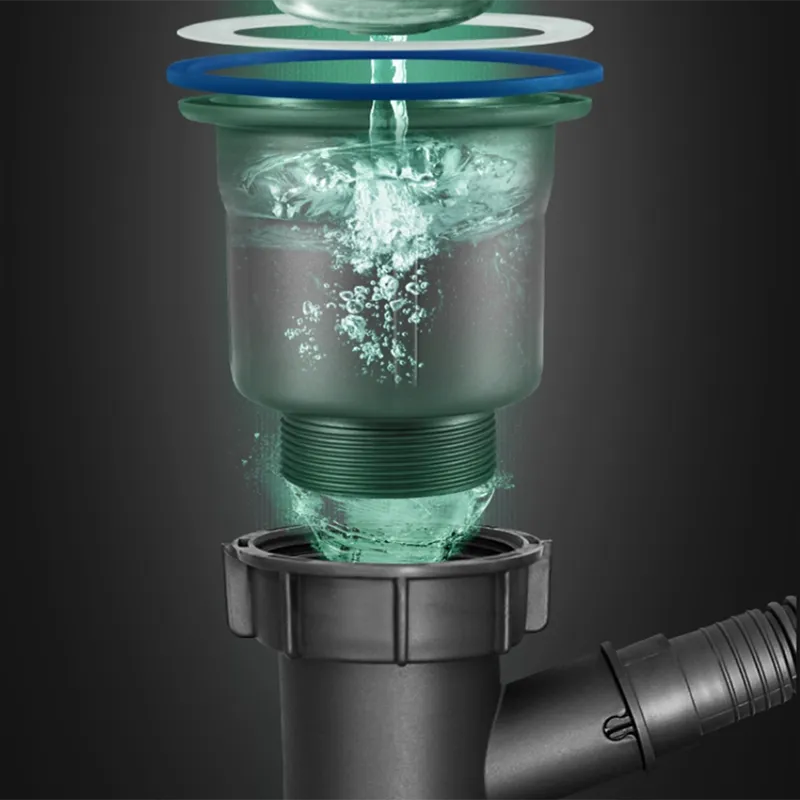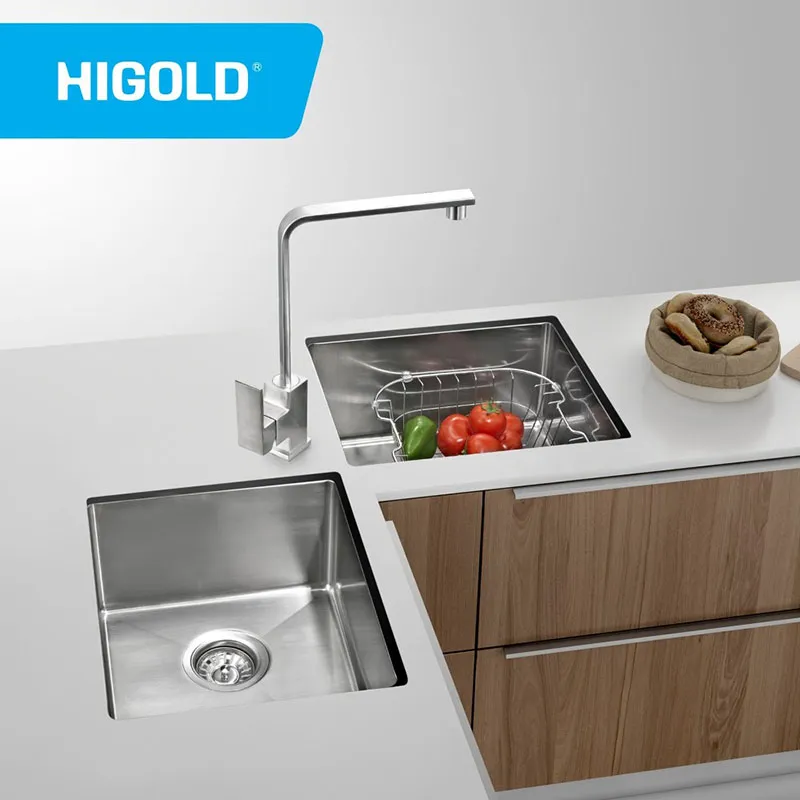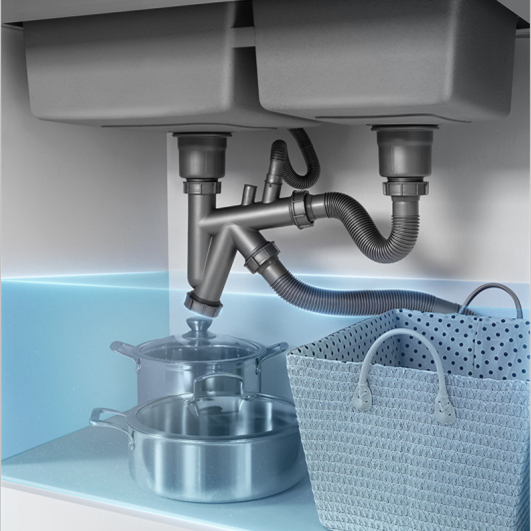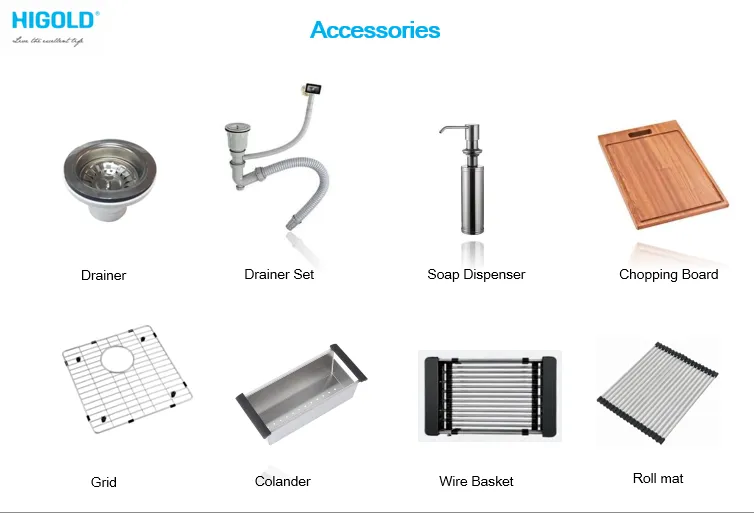The kitchen is a frequently used area in every home, and the sink is an essential fixture. Double bowl corner sinks have become increasingly popular in kitchen design in recent years. Their design not only improves kitchen space efficiency but also makes kitchen operations more convenient.
However, many people face a common problem when installing and using a double bowl corner sink: how to conceal the pipes beneath the sink. Exposed pipes not only detract from the kitchen's aesthetics but also easily accumulate dust and water, making cleaning difficult.
This article will detail the necessity of concealing the pipes of a double bowl corner sink, common concealment methods, relevant design considerations, and installation tips to help you achieve a kitchen space that is both aesthetically pleasing and functional.

Why conceal a double bowl corner sink?
1. Aesthetics
In kitchen renovations, exposed pipes often detract from the overall aesthetic. Especially in complex designs like double bowl corner sinks, the pipes beneath the sink often appear tangled and cluttered, creating a chaotic and disorganized appearance. If these pipes aren't effectively concealed, they not only affect the kitchen's appearance but also create a sense of clutter.
For homes pursuing a simple, modern design, concealing the kitchen corner sink pipes is particularly important. Concealing the pipes can add a fresh, uncluttered feel to the kitchen, enhancing the overall visual appeal of the space.
2. Hygiene and Cleanliness
The exposed pipes of a double bowl corner sink easily accumulate dust, oil, and water stains, which accumulate over time and make cleaning more difficult. Furthermore, the pipe joints and valves under the sink can become breeding grounds for dirt. Exposed pipes can also cause leaks and water stains, affecting kitchen hygiene.
Concealing the pipes not only reduces these hidden dangers but also avoids the safety issues associated with exposed pipes. Using appropriate partitions or cabinets to conceal the pipes also provides more storage space and prevents clutter.
3. Enhanced Sense of Space
For small apartments or kitchens with limited space, having exposed kitchen corner sink pipes can easily make the space appear more crowded and cluttered. Cleverly concealing pipes can effectively enhance the kitchen's sense of space, making it appear more spacious and tidy. Concealing pipes often requires considering the kitchen's spatial layout, carefully planning the pipe routing and installation method to avoid excessive space occupation.

How to Hide Double Bowl Corner Sink Pipes?
1. Using a Sink Cabinet
Sink cabinets are one of the most common ways to conceal pipes, especially in double bowl corner sink designs. Sink cabinets are typically made of wood or metal, offering strong load-bearing capacity and decorative appeal. Installing a cabinet underneath the sink effectively conceals pipes while providing additional storage space.
Key Design Points:
• Cabinet Layout: Design the interior space of the sink cabinet based on the kitchen corner sink's layout and pipe routing. Typically, the cabinet requires reserved space based on the location of the pipes to ensure proper operation and maintenance.
• Partition Design: The sink cabinet can be designed with multiple partitions to separate pipes from storage space. This not only conceals the pipes but also provides additional storage space without compromising plumbing.
• Cabinet Door Selection: The material and style of the cabinet doors can be chosen based on the overall style of the kitchen. Common cabinet doors include sliding doors and flap doors, and the choice can be tailored to your needs.
Advantages:
• Aesthetics: Sink cabinets effectively conceal pipes, enhancing the overall aesthetic of the kitchen.
• Practicality: In addition to concealing pipes, sink cabinets also provide ample storage space for cleaning supplies and kitchen tools.
2. Using Pipe Covers
In addition to sink cabinets, using pipe covers is another common way to conceal pipes. Pipe covers are typically made of materials such as PVC, metal, and wood, and can be customized to fit the shape and size of the double bowl corner sink pipes. By wrapping the pipe cover around the outside of the pipe, it effectively conceals the pipe and provides an additional layer of protection for the kitchen.
Design Key Points:
• Material Selection: Choose the appropriate material based on the kitchen's decor and the actual plumbing situation. PVC is suitable for kitchens with a lower budget, while wood and metal are more suitable for high-end decor.
• Personalized Design: Duct covers can be customized and made of the same material as the kitchen countertop or cabinets, creating a unified style and enhancing the overall design.
Advantages:
• Easy Installation: Compared to sink cabinets, duct covers are simpler to install, typically requiring only affixation to the outside of the ducts.
• Lower Cost: Compared to sink cabinets, duct covers are less expensive to manufacture and install, making them suitable for families on a budget.
3. Concealed Pipes in Walls and Ceilings
For some unique kitchen layouts, especially those with unusual double bowl corner sink locations, ducts can be concealed in the wall or ceiling. This method typically requires planning before renovation to ensure smooth insertion.
Key Design Points:
• Pipe Route Planning: Pipe routing should be planned early in the renovation process to ensure smooth passage through the wall or ceiling without affecting future use.
• Higher Construction Difficulty: Concealed pipes in walls or ceilings require specialized installation work, making them more challenging than other methods and potentially increasing renovation costs.
Advantages:
• Maximize Space: Concealing the kitchen bowl corner sink pipes within the wall or ceiling maximizes kitchen space and eliminates the need for pipes to occupy any space.
• Aesthetically pleasing: The pipes are completely concealed, eliminating any distractions from the kitchen's aesthetics.
4. Use Decorative Elements to Conceal Pipes
In addition to traditional cabinets or coverings, decorative elements are also effective ways to conceal pipes. Decorative screens, partitions, or other artistic elements can be placed beneath the kitchen corner sink to conceal the pipes. These decorative elements not only conceal the pipes but also add a touch of artistic flair to the kitchen.
Design Key Points:
• Style Matching: Decorative elements should complement the overall kitchen style to avoid visual clashes.
• Flexibility: This method allows for flexible design options based on the size and shape of the kitchen, offering more personalized options.
Advantages:
• Creative Design: Concealing pipes with decorative elements not only conceals them but also enhances the kitchen's visual appeal and aesthetics.
• Flexibility: Decorative elements can be designed to suit specific kitchen environments.

Considerations for Concealing Double Bowl Corner Sink Pipes
When concealing double bowl corner sink pipes, in addition to aesthetics and practicality, the following important factors should also be considered:
1. Pipeline Accessibility
Regardless of the method chosen for concealing the pipes, ensure that the pipes remain accessible. The pipes must not be completely sealed or blocked, as this will affect water flow and may even cause leaks. When designing the sink cabinet or pipe cover, adequate space and access should be provided to ensure proper function of the pipes.
2. Pipeline Repair and Maintenance
When concealing pipes, it is important to consider future repair and maintenance needs. Hiding the pipes too tightly can make later repairs more difficult. Therefore, it is recommended to leave sufficient repair space when concealing the pipes to facilitate quick repairs should any problems arise.
3. Waterproofing and Anti-Corrosion Measures
Double bowl corner sink pipes often come into direct contact with water, so waterproofing and anti-corrosion measures are essential when concealing the pipes. Using waterproof and corrosion-resistant materials for pipe coverings can effectively extend the pipe's lifespan and reduce damage caused by moisture or water seepage.

Can Higold supply products for government or public sector projects?
Yes, Higold has the capability and experience to supply kitchen sinks and hospitality faucets for large-scale public housing, education, and projects. With globally recognized certifications such as CUPC, CSA, and CE, the products meet international standards required for government tenders. The factory’s capacity and quality control make it a reliable manufacturer for buyers managing strict timelines and compliance requirements.


